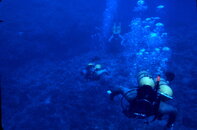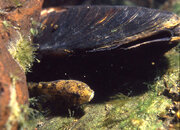That you were, John. That you were. My apologies.
Thanks, I just did a few calculations, as I now dive mostly my steel 72 tanks. But steel 72 tanks at 2250 psig (their stamped pressure) are not 71.2 cubic feet. That is only true if they are rated with a "+" sign, and filled to 2475 psig. So I worked your scenario using my tank type, after determining the actual amount of air in the tank at 2250 psig:
71.2 cubic feet / 2475 psig = X cubic feet /2250 psig
X cubic feet = (71.2 cubic feet * 2250 psig) / 2475 psig
X cubic feet = 64.7 cubic feet
So I set up the spreadsheet based on 2250 psi and 64.7 cubic feet of air. My RBP (1 diver) was 805 psig. For two divers, it was 1460 psig (I use "psig" to stand for "psi gauge"), as the absolute pressure would need to add the sea level pressure to that (14.7 psi).
Taking that information, and asuming that the 24.3 psi/min figure is correct (based upon my experience diving) I can find the approximate time I would have for the dive:
2250 psig - 1460 psig = 790 psig used to get to my RBP
790 psig / 24.3 psig/min = 32.5 minutes for my planned dive time at 80 feet.
Doing the same for a solo dive, with a turnaround RBP of 805 psig, I get:
2250 psig - 805 psig = 1445 psig used to get to my RBP
1445 psig / 24.3 psig/min = 59.5 minutes for my planned dive time at 80 feet.
BUT, I must use the actual air consumption rate, which at 80 feet is more like 82.6 cubic feet per minute (surface air consumption rate times the number of atmospheres depth). Looking at actual CFM/minute, the calculation looks like:
2250 psig - 805 psig = 1445 psig used to get to my RBP
1445 psig / 82.6 psig/min = 17.5 minutes for my planned dive time at 80 feet.
By the way, using my old dive tables from Dacor (1971), the no decompression limit for this dive is 40 minutes. So using the solo dive calculation on the spreadsheet, without thinking about decompression limits and the NDL of 40 minutes would potentially put the diver at risk of DCI.
BUT, I figured out that the actual air consumption rate at depth needs to be factored into these calculations, and using the 82.6 psig/min at 80 feet, the dive time for a solo dive would be 17.5minutes (9.6 minutes for a buddy dive).
Dive planning must consult both these issues (RBP and No Decompression Limits).
SeaRat
PS, it's getting late, and I may need to modify the rate of air consumption to absolute atmospheres instead of atmospheres of depth; I'll work on that later today (it's past midnight).
PS2, I've made the changes in the calcs.







